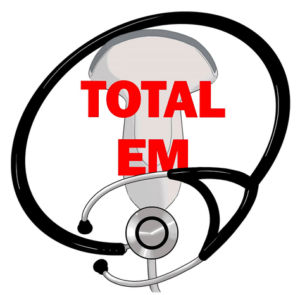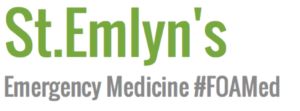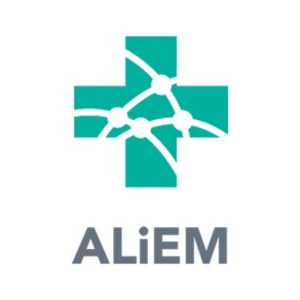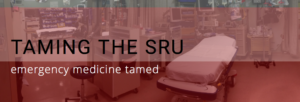Nursing FOAMed Review #3 (Aug 21st – Sept 10th)
Josh Farkas writes for PulmCrit (EMCrit) discussing his thoughts about the IOTA trial, his overall opinion on the sanctity of the meta-analysis, and what it means to judge a trial’s fragility index. When the IOTA trial came out in late April it made a pretty big splash. The trial purported to show that conservative oxygen management was clinically superior (lower mortality) when compared to liberal oxygen administration during treatment of acute illness. Obviously a study that shows we need to ease off the O2 (ahem….. read: pay attention to exact amounts and titrate based on actual physiological needs) was bound to cause a stir. We have previously tended to treat oxygen (at least in the field of nursing) like drug seekers treat Dilauded – the more we up the dose, the better the patient is going to feel! But Farkas is adept at finding the weak spots in any analysis – even a meta-analysis. His write up is great, his conclusions are solid – and he may just have changed some minds as to the inviolability of the meta-analysis.
Rory Spiegel writes again in EMNerd (EMCrit) and gives us The Case of the Needless Imperative. This is another brief review of the literature being thrown around right now concerning airway management during cardiac arrest treatments (pre-hospital in many cases) and focuses on the results of the PART trial and the results of the AIRWAY-2 trial. Both of these articles have shown poor outcomes for the ETT cohorts and have certain airway purists foaming at the mouth. Dr. Spiegel has a pretty measured take on things and it is always nice to hear a respected experts opinion when new data looks like it may start to upset the status quo.
Dr Anand Swaminathan writes for CORE EM about Cauda Equina. Nothing mind-blowing here, but sometime simple is best! This is an important review if you haven’t thought about this differential in a while. All those patients who come in with sciatica and lower extremity pain/weakness need to be asked important differential questions regarding urinary frequency/incontinence. Take a look at the symptom specificity and sensitivity breakdown here, and dive into the review – especially if you haven’t thought about Cauda Equina since nursing school.
Podcast #110 from TotalEM gives us a good literature review on IO access and how the IO drawback can effect our lab values. This is a question that gets thrown around a lot in the critical care bay. “If I get this blood from the IO, can I still use it to send samples down to the lab?” Or, “Can we use this stuff in an iStat POC test?”
This TotalEM podcast references two articles concerning the IO lab results question. Both studies are small (the 2010 study N=10 and the 2017 study N=31), but show that certain lab values on samples drawn from IO are consistently inaccurate. Some of these lab values are vitally important, and may dictate certain emergent treatment protocols (think about elevated serum potassium from an IO in a cardiac arrest patient which would point a resuscitation team to hyperkalemic protocols.) This is a great read (or listen) for those interested in having a more detailed answer next time the question about lab values and IOs is asked.
St. Emlyn’s has my favorite post for this entire FOAMed review with an article by Simon Carley concerning fluid resuscitation. The St. Emlyn’s post is mainly a response to a recent article published in Nature by Simon Finfer, John Myburgh & Rinaldo Bellomo entitled Intravenous fluid therapy in critically ill adults. Simon Carley brings us face to face with one of our most profoundly misunderstood interventions: IV fluids. This has been one of my favorite reads in a long time. Some of the incredible gems within (or at least linked to) Carley’s article:
- Why “normal saline” is anything but normal
- A quick literature review that may explain why you’re giving more LR and less NS recently.
- Why “fill ‘em up and diurese them later” may be more harmful than previously thought.
- Discussion about “buffered salt solutions” vs NS – for a more detailed discussion about the possible benefits of buffered solutions look at the original article hyperlinked above.
All in all, this is a fantastic write up, and I think that it should probably be shared as much as possible amongst any nurse that hangs fluids (everyone, right?). The pathophysiology breakdown concerning hypovolemia and the possible interventions, and how those interventions can be monitored, is truly fascinating. As nurses, we probably give more saline than any other drug. Read this article (and print out and read the original research by Dr. Finfer) if you want to have a better understanding of what it is you are doing to your patient when you hang that liter!
Steve Mathieu writes a great review for The Bottom Line concerning the above mentioned AIRWAY-2 Trial. Per usual with The Bottom Line, there are some amazing PDFs breaking down the results of the trial in true medical algorithm style.
One of the things that I find interesting (and maybe I’m missing something here, so if someone can write back and explain I’d love the assistance) is the survival rate of the patients that received NO AIRWAY adjunct at all and only received BVM intervention. These patients had up to a 25.2% survival rating as compared to 6.4% in the highest survival rating group amongst the SGQ vs ETT groups. I must be reading this wrong. Either that or the obvious results here tell us that we need to ONLY be using BVMs in the field if we care about patient outcomes.
The EM@3AM series from emDocs brings us a review on Ludwig’s Angina. I’ve never had a patient present with Ludwig’s while working in my ED, but I’ve had a few that had symptoms that put Ludwig’s high on the immediate differential – and it is enough to make everyone in the room pretty nervous. If you aren’t familiar with Ludwig’s Angina, it’s presentation or sequelae, this is a great article for you. There is a review of the typical case presentation, as well as the pathophysiology behind that presentation. The biggest takeaway should be that Ludwig’s Angina = airway emergency!! Not only do we need to get the airway cart out and prep for probable RSI, a surgical airway kit needs to be ready. A fair number of these patients require emergent surgical airway management. The other surprise is the high mortality rate these patients experience if not recognized and treated early (while those that are treated properly have a less than 8% mortality).
There is a short reference list at the end of the article as well as a link to a Life In The Fast Lane article that was updated this May if you are interested in a deeper FOAMed dive into Ludwig’s Angina.
Another nerve block technique for migraine headaches? Yup! I don’t know if I will ever really see this technique being used, but new information is always good – even if you don’t think you’ll personally ever use it. Dr David Cisewski at Icahn School Mt Sinai writes about GONB (greater occipital nerve blocks) for pain control in migraines refractory to treatment with Metoclopramide. This study by Dr. Friedman shows that the technique potentially effective in controlling migraine pain – but the study is small (N=28), the intervention seems unlikely to gain traction (Bupivacaine injected around the occipital nerve with sono assistance unlikely unless we want to start shaving heads) especially in emergency departments, as the definition of migraine within the contexts of the study doesn’t necessarily match any particular emergency definition, or restraint on the treatment, of severe headache pain.
Whether you plan on recommending Dr. Freidman’s technique or not, the emDOCS review is a great bit of reading. Dr. Cisewski reviews a formal definition of migraine (something I needed to review for sure) and goes over some standard treatment protocol. It also has a short discussion on the pitfalls of Hydromorphone use for headaches during this modern era of narcotic abuse.
This reminds me of another cringe worthy treatment option for headache brought up in ALiEM back early in 2017. How bad does your head have to hurt to do this stuff?
Leave it to ALiEM to write about Betel Nut. If you don’t know what Betel Nut is, just clink on the hyperlink. I once responded to a patient with a chief complaint of syncopal episode – her husband told us that it was from chewing too much Betel Nut. We spent more time on Google trying to figure out what the heck he was talking about than we spent looking at the patient. Medically obscure as Betel Nut poisoning may be – it is always fun to learn something new.
Dr Evan Kuhl, Natalie Sullivan and David Yamane write for ALiEM concerning resuscitation of a drowning victim. It’s summer and everyones at the beach or in the pool. This review is necessary not only because of timing, it is good information for any resuscitation, ED or CC nurse. The patient presenting with drowning is full of medical truisms – most of which end up as falsehoods the second we reference the literature . Get rid of all the BS and pack in the facts. As they say in FOAMed: it is time for some dogmalysis. Here are some great pearls from this review:
- Dry drowning is not a thing. I repeat – DRY DROWNING DOESN’T EXIST!
- Salt water drowning vs pool water vs bathtub vs brackish??? Nope, nope, nope! Volume of water inhaled into the lungs matters – composition of the water does not seem to have an effect on outcome.
- Isn’t cold water better to drown in than warm water? No. Submersion time is more important to outcome than submersion temperature.
Dive into (ahem… sorry for the pun) this article and go deep with the literature review at the end. 13 articles for your FOAMed leisure.
It really isn’t a FOAMed review without something from CanadiEM right? So here is a write up from those crazy Canadians (and some folks at The Johns Hopkins) about a new paradigm in resuscitation medicine. Introducing the CPR coach during ACLS resuscitation.
The article outlines an interesting concept. Add another team role to the mix – a leader amongst the CPR team that is called the CPR coach. This team role is only responsible for managing the quality of CPR quality during resuscitation. The idea is that the Team Leader can focus on ALS, complex procedures and Hs and Ts, while the CPR coach can focus on fixing our almost universally abysmal numbers related to compression depth, compression fraction, breathing rates, time-off-chest percentages etc etc etc. Some very interesting results in these preliminary studies. Definitely worth a read for those of us interested in resuscitation medicine.
Dr Anand Swaminathan was busy this last month. Not only did he do a quick review of Cauda Equina for CORE EM, but on R.E.B.E.L. EM, he also gets into the controversial results of the recent PRISMS study comparing Alteplase to Aspirin in mild stroke. In his review of this article, Dr. Swaminathan goes back to the results of the NINDS studies that ushered in the modern era of Alteplase use in stroke care. If you aren’t familiar with NINDS, and if you aren’t familiar with the controversy concerning Alteplase, you MUST read this article. While most cursory reviews of the PRISMS trial tend to lean towards Alteplase as the safe method of treatment, R.E.B.E.L. EM puts the onus of proof back on the advocates of Alteplase when he states that multitude of reasons why Alteplase is not necessarily the miracle drug it is treated as within certain circles. Read the review and ask yourself – “If I were having a mild stroke would I want Alteplase or Aspirin? It isn’t as easy a question to answer as some would have you think.
Taming the Sru has a quick review on ED diagnosis of Necrotizing Fasciitis. I’ll be the first to admit that dermatology isn’t my strong suit. But knowing that these patients have a high mortality morbidity, and that nurses are the front line for triaging the vast majority of these patients, I really think that any ED nurse could benefit from reading this review.
One great aspect of this article is the breakdown of the fragility of the LRINEC score system for diagnosis in the ED. Long story short – if you have this score saved under your MDCalc page, you might as well ditch it. The sensitivity is just too low for such a high risk diagnosis. So read the article and find out what to look for. Early recognition and treatment results in better outcomes for these patients! If you have a high index of suspicion for this diagnosis, it might be time to up-triage the patient or ask for a physician consult in the triage area.
Nursing FOAMed Review #2 (Aug 9th – Aug 20th)
Dr Benoit from Taming the SRU gives us a list of his top “practice-changing” articles for 2017-2018 in the “grand-rounds recap” series. An awesome line up of some really great articles for anyone who is interested in critical care or emergency medicine. Every article listed is conveniently hyperlinked to publication sites. So if you are in a med lit sort of a mood, email this link to yourself and get to your nearest medical library and do some reading. This might be the best power line-up of medical literature you’re going to see for a while. Some highlights:
- Effect of treatment delay on the effectiveness and safety of antifibrinolytics in acute severe haemorrhage: a meta-analysis of individual patient-level data from 40 138 bleeding patients
- Effect of Use of a Bougie vs. Endotracheal Tube and Stylet on First-Attempt Intubation Success Among Patients With Difficult Airways Undergoing emergency Intubation
- Prevalence of Pulmonary Embolism in Patients With Syncope
- Mortality and morbidity in acutely ill adults treated with liberal versus conservative oxygen therapy (IOTA): a systematic review and meta-analysis
Dr Rick Body writes this article for St Emlyn’s about a vitamin supplement that could be giving us false negatives on our Troponin tests. Apparently Biotin (aka vitamin B7) supplementation can affect specific POC and laboratory Troponin tests. The article points out the up to 7.7% of American patients may be taking supplemental Biotin (probably for hair and nail growth – even though there is apparently no good evidence that Biotin works to correct these ailments). The article contains an exhaustive list of the specific Troponin assay tests that Biotin can affect. It’s an interesting read that makes me think perhaps nurses need to start asking about Biotin supplementation prior to pulling troponin immunoassay labs.
St Emlyn’s also has a short bit on some of their contributor’s favorite apps. I love sharing quality learning apps, so I have to share this link. These apps are supposed to be “new” – but looking at release dates, many of them have been out for a long time. Among those of real interest to me are the POCUS apps available. Some are free and some are expensive – but definitely worth a browse for anyone interested in a quick FOAMed diversion on their phone while standing in line at Starbucks.
Among some of my personal favorites missing from this particular list are WikEm, Figure 1, and UBC Radiology. Check them out for a quick bite of FOAM on the go.
emDocs has an incredible write up by Paul Zentko with some great clinical pearls on psychiatric medications in the ED. Some pretty eye opening numbers pertaining to psych meds contained within this article, such as: up to 1 in 6 adult adults in the US fill a psych med prescription at some point in the year, and up to 10% of ED visits due to adverse drug reactions are related to psychiatric medications. It is a short article but does a great job going through a relatively thorough review of:
- SSRIs
- A quick SSRI med review – names, prevalence in the general population and discussion of relative safety and overdose concerns.
- Notes on the relative dangers of citalopram and escitalopram concerning seizure activity and EKG changes.
- Links to a wonderful and super helpful tox card on the differences between Neuroleptic Malignant Syndrome and Serotonin Syndrome
- Abrupt discontinuation leading to “discontinuation symptoms”
- Lithium
- Discussion of narrow therapeutic index and treatment considerations for acute v chronic overdose
- nice overview of lithium excretion/metabolism
- Typical v Atypical Antipsychotics
- Lists of common medications in these classes
- Good review of EKG changes to expect and what risks these medications can pose for our ED patients.
- Overdose treatment protocols
Another awesome aspect of this article is the to Dr Katy Hanson’s website. Check out her drawing at the bottom of the article with all the different psychiatric medications and tell me if you can think of a better way to learn these drugs!? Without her drawings I would have had to do a lot more dry and boring studying to get through anatomy and physiology. If you haven’t checked out her page yet you really should.
Dr Josh Farkas writes in PulmCrit about the use of BP monitoring in septic patients on vasoconstrictors. While this article at first appears to be only geared towards critical care docs, we need to take a moment and see how it can be applied to those of us (doctors and nurses) that work in an ED setting. Even if this literature review doesn’t change practice, we should all be aware of the information broken down in the review. Nurses caring for patients on pressors must be made to understand that there can be a propensity to over dose on pressors if radial sites are being used instead of femoral sites for arterial blood pressure monitoring. Read the article to understand the difference in accuracy between non-invasive BP monitoring and what the available literature tells us about the difference between radial and femoral arterial BP MAP monitoring when the patient is on pressors. Per usual with EMCrit, there is a phenomenal breakdown of the available high-quality data, a simple discussion of why this data may change our understanding and approach to invasive blood pressure monitoring, and then a recommendation for future practice.
Dr Sean Hickey writes this about TAPSE (a POCUS test called tricuspid annular plane systolic excursion) for PE risk assessment and prognostic considerations. It seems like an easy enough bedside test for anyone who has gone through a ultrasound course/fellowship. I like this article’s timing because it ties in so well with the thorough review of PE published in Emergency Medicine Cases that I have tagged in this same FOAM review. (Thank you EMCrit for the sources cited list – about 50 articles long here if you want to dive super deep into TAPSE tests.)
CanadiEM adds to their “Blood & Clots Series” with this article discussing PE diagnosis in late stage pregnancy. Dr. Eric Tseng writes about these main takeaways from the current literature that we need to be aware of:
- Wells Score and D-Dimer are not predictive within the pregnant population (at least not yet as there have been no published studies confirming utility) so we cannot be effectively utilizing those prognostic tools on these patients.
- Recommendation to use bilateral compression ultrasound as a precursor to V/Q and/or CT-PA as if the ultrasound comes back positive, treatment is the same.
- According to the literature sites in this article, both V/Q and CT-PA are deemed safe (sub-teratogenic) for pregnant patients.
Paula Sneath is a PGY1 that wrote a great piece on esophageal foreign body obstructions. Nothing mind-blowing here, but a great review of the anatomy, patient population, and possible negative sequelae on patients presenting to the ED with EFBOs. A couple of very interesting points:
- A quick discussion on Glucagon for these patients – to administer or not to administer, this is the question still apparently. Rosen’s says no, other sources are still clinging to weak evidence despite the known side effect of vomiting which can take this patient from bad to worse.
- A rundown on upper EFBO removal with a Foley catheter. Which, if I’m going to be honest, I am going to bring up EVERY time I see a upper EFBO from now on. Forever. I can’t wait to see someone shove a Foley down an esophagus, inflate it, and slowly pull up a meat bolus.
Dr Joseph Levin, a PGY4 at Bellevue writes for R.E.B.E.L.em about C-spine clearance in the ED for ETOH patients. this is a short but sweet review on this article from the Journal of Trauma and Acute Care Surgery. Among the interesting pearls:
- Not that it is highlighted – but the numbers seem to indicate that ETOH and illicit drug intoxication c-spine injuries are 2x that of ETOH alone. An interesting find when looking at the injury rates among different patient populations.
- This conclusion: “For intoxicated patients with a negative cervical spine CT, there appears to be little benefit to maintaining prolonged immobilization unless there is an obvious neurological deficit or high degree of suspicion for cord injury. This is consistent with previous literature in CT performance in obtunded patients.”
R.E.B.E.L.em also wrote a quick review on HFNC (high flow nasal cannula) for those that aren’t quite familiar with this wonderful tool. We are starting to see this used more and more in adult EDs across the country – as nurses we need to get used to the idea that HFNC is a tool we are going to need to be comfortable with. This hyperlink above is only the first part of the article – and reviews the functionality of HFNC and not it’s use in treatments. Stay tuned for “part 2”.
Dr Anton Helmen of Emergency Medicine Cases writes an incredibly thorough article on diagnosing PE in the Emergency Department. (There is a podcast to go with this article, which I will try to review later – but clear 93 minutes out of your schedule if you are interested in listening.) This article is thorough, specific and has loads of great hyperlinks to other opinions, articles and websites – backing up all the recommendations with well known studies and really taking a deep dive into the numbers that we should all be aware of. If you have the time to spend, this is a great review of diagnosis and treatment and care of PE in the ED.
- Mortality rates and, in my opinion, the absolutely terrifying finding that “85% of PE mortality in ED patients occurred in untreated patients while waiting for diagnostic confirmation according to EMPEROR Registry.”
- A high quality pearl on how to parse out true exertional dyspnea.
- A logical an no BS approach to how we should implement the PESIT trial (Syncope and PE in the ED). (Basically: we should be treating chief complaint of syncope like we do everyone else when considering or ruling out possible PE.)
- 50% of PEs are found in patients with no 0 Wells’ Score.
- A quick EKG rundown talking about the lack of sensitivity of S1Q3T3 and reminding us to look for inverted T waves anterior and inferior leads as this is the most specific finding on an EKG.
While we are on the subject – might as well link to the MedCalc Wells’ Criteria as well as the PERC score so that we can all review if we don’t have it memorized.
Nursing FOAMed Review #1 (Aug 1st – 9th)
ALiEM brings us a great overview of maternal cardiac arrest. This article also comes with a link to ALiEM Cards on the same material. If you have never browsed the ALiEM Cards before – they are amazing and definitely worth your time. Articles such as this are always appreciated – any lesson on resuscitation that goes beyond the typical AHA ACLS course is worth a mention. Some really great takeaways here include:
- A great list of common causes of maternal cardiac arrest.
- How to anticipate potential magnesium and calcium based pharmacological treatment of arresting maternal patients.
- Recommendations of IO access above the diaphragm!
- Knowing to expect immediate C-section if ROSC is not within only 2 rounds of CPR.
- Intralipid use guidelines for patients with arrest after potential anesthetic toxicity.
A couple of very good FOAM sites have write ups on Morphine use in acute heart failure. Dr James Fletcher guest writes for R.E.B.E.L. EM on this post. The post references this article, a multicenter, observational, propensity matched cohort study, that compares mortality rates among two groups of acute heart failure patients – those that received Morphine and those that did not. There are some issues with the study, all of which are thoroughly discussed within the article written by Dr. Fletcher. There are also a few other studies mentioned that link Morphine with increased mortality in patients who present with acute heart failure.
One of the best takeaways from this review is this small segment: “The European Society of Cardiology guidelines on the treatment of heart failure recommend against the routine use of opiates, while the American Heart Association recommends opiate use in heart failure be limited to the palliative care of patients with end-stage HF and severe respiratory distress.” As a nurse, we sometimes find ourselves turning to Morphine for AHF patients, and sometimes not. This article can help us understand what our physicians are thinking.
emDocs did a similar article, but with a bit wider scope. Entitled Myths in Heart Failure: Part II – ED Management, this article is less of a single article review, and more of a case study about patients presenting to an emergency department with acute heart failure with concurrent hypertension. This emDocs article reiterates the lesson from R.E.B.E.L. EM about Morphine potentially increasing mortality for AHF patients, but there is also an incredibly thorough list of clinical pearls for AHF with hypertension such as: guidelines for diuresis, use of nitroglycerine, the aforementioned consideration of opioids, and a very cool bit on ultrafiltration for patients refractory to front line diuresis treatment. (This is the second part of a series from emDocs, the first in the series, an article called Myths in Heart Failure: Part I – ED Evaluation was published in late July and is definitely worth a look.)
A very prescient article concerning pain management from Annuls Of Emergency Medicine has sparked some chatter on emDOCS.net. Anyone who still works in an ED that is handing out Dilaudid like candy knows that we are contributing in our own way to the opioid epidemic. emDOCS.net shares a great article by Doctor Casey Wilson on nerve blocks on their use in emergency departments for the control of pain. (If you don’t have access to Annuls of Emergency Medicine there is a great podcast that gives you a quite thorough roundup here.) According to Dr. Wilson nerve blocks can be used for “fractures, joint reductions, complex laceration repairs, chest tube placements and paraphimosis” and have been shown to be even better than opioids for some older patients with femur fractures. Not that I wish any nurse to be flooded with paraphimosis cases – but the article is pretty cool in that it explains the simplicity of ultrasound guided nerve block procedures while providing readers with some great PDFs. Another really interesting point, especially for those wanting to increase throughput in the ED, references (small) study done in 2008 in the American Journal of Emergency Medicine which showed ultrasound guided nerve blocks for upper extremity injury actually reduced the average length of stay in the ED by 3 hours! A very cool share and worth a link to your Sono Fellowship director.
CoreEM brings us a great review on Acetaminophen overdose written by Dr. Magda Robak. This is a simple but effective teaching module for anyone who wants to review the most common single cause of acute liver failure in the US. The article reviews the Acetaminophen nomogram and also shares a simple but fantastic spreadsheet that I think can be very useful, especially for nursing triage and early nursing care:
Justin Morgenstern writes for First10EM and shares with us a case study on post tonsillectomy hemorrhage. This is one of those great FOAM articles that really packs a huge punch. First10EM takes a patient that seems simple enough – a potentially severe oropharyngeal bleed – and takes a quick, but incredibly thorough dive, into treatment considerations in the ED. There is a lot here for the ED nurse to unpack. Some highlights from this article include:
- Simple positioning of the patient makes a huge difference in management in the first minutes of patient care.
- This patient may need a blood transfusion! IV Tranexamic acid may be called for, but surprisingly DDAVP can also be empirically used, as undiagnosed Von Willebrand disease is apparently somewhat common in these patients.
- To use an NG tube or not to use an NG tube – a great discussion between two ED docs.
- Stop the bleeding is the name of the game – but what to do first? Try direct pressure with McGill’s forceps, or stick your fingers in the mouth and try to apply direct pressure with some gauze soaked in tranexamic acid and DDAVP? If none of those options work, or if they are not plausible, should we try to apply pressure to the carotid?
- Intubation considerations, and which drugs might need to be prepped for induction.
- Simple recommendations are sometimes the most amazing – while we are all running around focusing on stopping the bleed, make sure you don’t forget to recommend antiemetics! The patient has probably swallowed a lot of blood and an episode of violent emesis can destroy any clot that is beginning to form, so make sure to remember that the patient needs a hefty dose of antiemetics.
The Bottom Line writes a critical review of the PAMPer paper that was published in late July by NEJM. This trial aimed to find a difference in survivability between air transported trauma patients that received either fluid crystalloid boluses, or plasma. This Bottom Line post outlines the strengths and weaknesses of the PAMPer trial, as well as a short review of other similar trials, and why PAMPer is potentially so impactful. The paper showed a significant increase in survivability in the plasma group, as compared to severe trauma patients who received fluid crystalloids only. The study shows a 10% drop in mortality with an intervention of 600cc of thawed plasma. This mortality drop is so dramatic for such a slight intervention change, that there is a portion in The Bottom Line review that states the “biological plausibility” is questionable, which seems to be a nice way of saying that there are probably biases within the study that partially explain the survivability differences.
Either way, the PAMPer trial in NEJM, and The Bottom Line’s review of the article, are great reads for anyone who works air emergency treatment and/or Level 1 trauma medicine. We’ve known for some time that flooding patients suffering from hemorrhagic shock with NS increases our coagulopathy, acidosis (NS has a pH of approx. 5.5) and (unless the fluid is warmed) the likelihood of hypothermia. Treatment for traumatic hypovolemia that shoves the patient into the “trauma triad” should probably be avoided – so expect more trials like PAMPer and, hopefully, a change in paradigm in pre-hospital treatment for hemorrhagic shock patients.
Kristina Kipp writes for EMCrit to bring us a short review on an article that discusses the efficacy differences between Propanolol v Metoprolol in electrical storm arrests. This article from the Journal of American College of Cardiology is another piece of literature we can add to our arsenal of emerging information concerning electrical storm arrest patients. If you haven’t worked an electrical storm arrest resuscitation, this is a great article to get a glimpse at what may be different than a typical ACLS code. If you have worked an electrical storm resuscitation, read this article to see if your resuscitation team is following the newest recommendations in this emerging sub-class of VF or VT arrest. There is a great list of references at the end of the EMCrit article that is worth a review as well.
The first time I’d ever read about beta blockers during cardiac arrest was in CanadiEM almost a year ago. The infographics in the CanadiEM article are really fantastic and outline the basics of the pathophysiological logic that is applied to electrical storm arrests and why these particular resuscitations are so much different than our typical AHA ACLS boilerplate codes.
Not that this is typical FOAM sharing but – just wanted to link an incredible article from MSF on America’s attempt to ignore evidence-based practice and obliterate global women’s health access. The “Global Gag Rule” will link the funding of HIV treatment, tuberculosis programs, mother and child care, and other global health initiatives to regressive and morally bankrupt dogma. Read here to learn more about the view from the ground. https://www.doctorswithoutborders.org/new-global-gag-rule-more-dangerous-ever
Attendings & AHA Certifications

AHA Every Two Years
I have been an AHA instructor for about 4 years now. I can honestly say that most days I love to teach, but like most people, I have certain groups that I prefer. My favorite classes tend to be heavy with advanced practitioners and doctors – oh, and I love teaching residents. AHA material can get dry after a while, but a great practitioner can be a walking and talking reference manual for my recertification courses; full of facts, able to cite pertinent studies from memory and, at least in my experience, most are willing to drop some awesome pearls for the benefit of the other members of the class.
But not all classes are a pleasure to teach. Recently I taught a PALS class that didn’t go so well. One of my favorite EM docs had a group of 3rd year residents that required a short notice recertification. A multitude of factors made this class less than ideal, but the attending and the training center both bent over backwards to accommodate the graduating residents. Let’s just say that it was a less than positive experience. The only question during the class was “how long is this going to take?”. The students chatted through the video material, generally tried their hardest to not pay attention, and engaged in such loud side conversations during lecture that I had to ask them to stop multiple times. It was, to say the least, a very disappointing class.
But here is the thing: I get it. Doctors spend residency being grilled and challenged and tested and pushed. These particular residents have studied under incredible doctors and have done rotations at one of nation’s leading children’s hospitals. They are eager to move on to new attending jobs, they are exhausted from years of outrageous study, and have (nearly) completed the almost super-human task of becoming a licensed physician in the US. Beyond their level of training and preparedness, there is also the fact that AHA courses are, unfortunately, just another merit badge class. Hospitals use these courses to create the convenient situation where the hospital can outsource provider training and therefore all liability and responsibility. Why spend time and money investing in staff education and training when the AHA gives out these fancy cards? I get it – it can really feel silly taking
So why in HELL do my outrageously overqualified doctors need to take ACLS and PALS? Who thinks this is a good use of time?I’ve created a checklist. It isn’t exhaustive and it’s just my opinion, but if you are a graduating resident, or even an attending, and you can only be dragged kicking and screaming in order to recertify PALS or ACLS, perhaps this list might help put these AHA classes in a different perspective.
#4 – You Know What They Say About Assumptions…
I love my residents. They are smart. They are incredibly motivated. And most of all they tend to have a sincere passion for medicine. But not every doctor I’ve ever recertified has been well rounded. I wish I could say that docs don’t need this stuff, but unfortunately there are some attendings out there that haven’t really studied this material in years. I’ve been in codes with docs who do some downright goofy stuff. I’ve had residents shoot me incredulous looks while we try to pace asystole or take 5 minutes to sono a coding patients heart – all under the orders of an attending. So no, we can’t assume doctors are proficient in AHA standards and you can’t skip the class – even doctors should be reminded of the ECC standard every two years.
#3 – Sharing Is Caring
This is especially important if you are one of the few, or the only, doctor in the classroom. Not everyone has your education, knowledge and experience. Please be a positive resource to the rest of the class! As mentioned earlier, the AHA material can get pretty dry. If you have a good story that pertains to the information being taught, please chime in. Some of the best and most memorable teaching moments have come from doctors telling the class how something works, or doesn’t work. Assist the instructors with some of the material – for crying out loud help make this stuff interesting! You have better stories than us. Please share and make this a great educational experience for everyone.
#2 – Times They Are a-Changin’
The AHA guidelines are updated every 5 years. But our field changes daily. This is a fantastic opportunity to sit down with your fellow doctors and review basic guidelines. If the guidelines are similar to your practice than great! Let’s discuss the evidence in support of the AHA benchmarks, and even better, lets discuss why we don’t do what we may have done in the past. But sometimes things change faster than the AHA can keep up with. Pediatric therapeutic hypothermia anyone? Why or why not? Antibiotics for pediatric sepsis? But of course – but what cocktail are you using? How much, at what point, and what are the other options? These classes are an incredible opportunity to hone your skills. The resident class I taught argued with the PALS recommendation for fluid resuscitation for pediatric cardiogenic shock. One of the students went so far as to say that fluid was stupid and that dopamine was the only serious option. Maybe that is true, but maybe there are other opinions in the room. Is there controversy right now about dopamine versus norepinephrine in shock patients?* If you are too busy proving you are too smart for the AHA course material, we won’t ever get to opportunity to have some pretty important discussions.
#1 – It’s Not All About You
This is the most important thing to remember: the standards set forth by the AHA may seem simple, pedantic, or even incorrect to your well-educated medical mind, but this is what all of your nurses, NPs, and PAs know as gospel! Your education and experience doesn’t mean you’re beyond AHA standard – it actually means you are responsible for the entire resuscitation team’s grasp on the AHA standards. Stop recertifying AHA courses with the idea that the instructor is only here to test you out on your skills. You’re an attending. You think I’m impressed that you know that ventricular fibrillation needs defibrillation? Of course not. Take this recertification course as an opportunity to sit down and think about your team. This isn’t an 8-hour recertification class for you – this is a course where you get to familiarize yourself with your staff’s training standards. I know these classes may seem pedantic to you, but this might be the most cutting edge resuscitation science your nursing staff has ever been exposed to. Don’t like what you see? Fantastic! Ask me why the AHA isn’t talking about dual sequential defibrillation for VF electrical storm. Ask me about ECPR. Let us discuss where the AHA gets it right and where you think it might get it wrong. These classes offer you the opportunity to see how your staff is being trained. Don’t like what you see? Fine – take the class and then go talk to your nurse educator and come up with a plan on how to expand the curriculum. But you have to take the class. I get that the videos are boring, and I know you’ll pass the test and breeze through the mega codes. But you have an opportunity here to be a great healthcare leader so take it – you owe it to your patients, and you owe it to your team.
